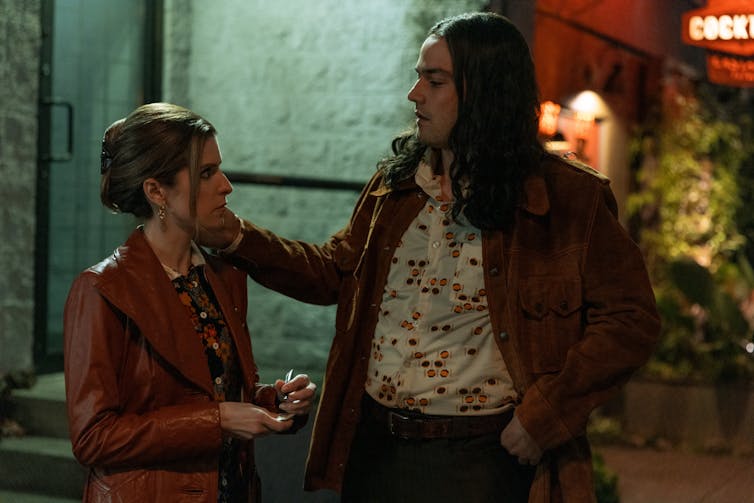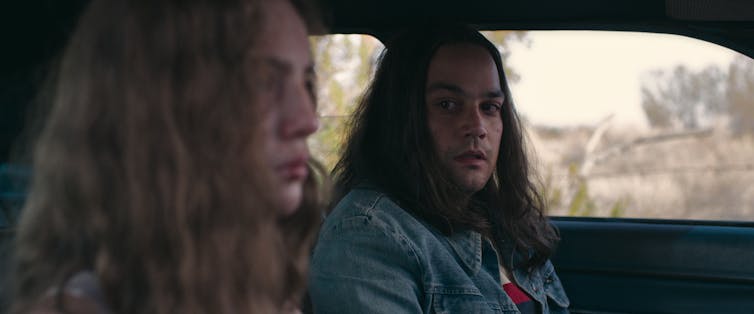
At first glance, Netflix’s Woman of the Hour is yet another true crime fictionalisation that plays to our preoccupation with American serial killers of decades past.
Directed by Anna Kendrick, who also plays the female protagonist Sheryl Bradshaw, the film reconstructs the crimes of serial rapist and murderer Rodney Alcala, aka the “dating game killer”. Alcala famously appeared on (and won) a television matchmaking show in 1978 amid a years-long killing spree.
The film examines historical sexual violence at both the individual and institutional level. It exposes the intense physical and psychological cruelty Alcala inflicted on his victims, as well as the cruelty and misogyny of the patriarchal culture that enabled such behaviour.
Woman of the Hour is a groundbreaking text: it’s the first feminist true crime film to achieve commercial success since the #MeToo movement gained momentum in 2017.

Seeing and being seen
Woman of the Hour inverts the sadistic and voyeuristic “male gaze” of traditional true crime by obliging viewers to identify with the female victim rather than the male perpetrator.
As film theorist and gender studies expert Sarah Projanksy observed in her influential book Watching Rape:
Depictions of sexual violence in most horror and crime thrillers run the risk of extending and reproducing eroticised violence against women, even when victims fight back.
But Kendrick’s directorial debut doesn’t romanticise Alcala or glorify his crimes. There are no cowering or moaning victims shown in various stages of undress.
Instead we see, through careful framing and close-up shots, the panicked discomfort of Alcala’s victims as they navigate the dangers of dating, the damaging effects of casual misogyny and the ever-present threat of male fragility.
As Margaret Atwood once said, men are afraid women will laugh at them, while women are afraid men will kill them.

“Did you feel seen?” Alcala asks Sheryl, after the aspiring actress appears with Alcala on The Dating Game in an attempt to be “seen”.
“I felt looked at,” Sheryl responds.
The tense interactions between predator and prey build an almost unbearable suspense for viewers, who have already seen through Alcala’s superficial charisma and charm.
Alcala was an amateur photographer who often exploited his victims’ desire to be understood and “seen”, and would lure them under the pretence of taking their photo.
The film’s unsettling dialogue and intelligent use of visual metaphor frames women as objects to be looked at, but with a twist: the female characters are aware they’re being tracked and entrapped (even if the realisation comes too late).
In subtle but devastating ways, Kendrick presents the horrific rape and torture committed by Alcala from the viewpoint of the victim. The camerawork underscores the victims’ feelings of shock and disorientation, but never in a voyeuristic or gratuitous way.

A game of murder and romance
Woman of The Hour implicitly suggests part of Alcala’s perverted pleasure in killing came from his gamification of this process.
In the film, Alcala strangles and then revives his victims, sometimes several times, before resubjecting them to the horror of his violence and the knowledge of their own death. His appearance on The Dating Game is the ultimate power move in his game of murder and romance.
“I always get the girl,” Alcala smirks at a fellow contestant.
His challenge extends not only to Sheryl, the blind date on the other side of the screen, but to the entire studio audience and the viewers at home.
However, the film makes clear that romance was never Alcala’s goal. Instead, he leverages the game of romance to exploit his victims’ vulnerability and trust. In this respect, the game is rigged in his favour.
When a woman in the audience recognises Alcala as the man who raped and killed her friend years prior, she attempts to report her concerns to the show’s producers, only to be fobbed off by a security guard. In another act of cruel male deception, the guard tells her to wait for a “senior executive” who he knows is actually the night janitor.
Women, it seems, are simply pawns in the patriarchal game of 1970s America – an era when women’s testimonies of sexual abuse and harassment were distrusted and their safety routinely overlooked.

Alcala after #MeToo
The women who survive Alcala’s violence in Woman of The Hour are those who perceive the artifice of his romance script, before inverting that script and presenting it, equally convincingly, back to him.
When teenage runaway Amy wakes in the remote desert after Alcala has brutally raped and assaulted her, she outwits him by coyly asking him to keep what has happened a secret.
By luring Alcala into a false sense of security, Amy convinces him to spare her. When Alcala pulls into a gas station, she flees to a nearby diner and alerts the police, who arrive and arrest him.

In the end, Kendrick’s message is explicit: “There’s no happy ending with a story like this.”
This post-#MeToo take on Alcala’s violent crimes is a commentary on the systemic misogyny – including the failings of the police and judicial systems – that allowed a serial killer who went on national television to evade detection.
Kendrick, the woman of the hour, refuses to look away.
The authors do not work for, consult, own shares in or receive funding from any company or organisation that would benefit from this article, and have disclosed no relevant affiliations beyond their academic appointment.
This article was originally published on The Conversation. Read the original article.







